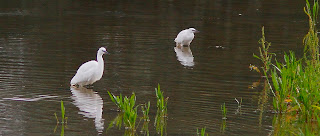An Osprey flew east at 09:15 ish; waders continue to pass through 8 Lapwings flew south, a Ringed Plover arrived from the north, 6 Common Sandpipers (4 along the dam & 2 near the yacht club), 8 Green Sandpipers on the lagoons and a couple of Redshanks; larids were represented by 7 Yellow-legged Gulls (2 ads, 4 3rd calendar years, 1 4th calendar year), 17 LBB's just 3 GBB's and an interesting 3rd calendar year gull that was most likely a Caspian Gull (see below).
Otherwise 6 Little Egrets (3 juveniles), 6 Common Terns and an adult Spotted Flycatcher near the dam were the highlights. An early passage of Swifts south c.250 was indicative of the poor breeding season that they have doubtless had and for similar reasons most warbler species are still singing frequently including 2 Cetti's at the lagoons; 3 adult male Yellow Wagtails were carrying food at the north side of the dam.
 |
| Garden Warbler |
 |
Little Egrets An interesting Gull |
This gull was near the dam in the company of Yellow-legged Gulls and LBB's early morning only after which it flew off south. Aged as a third calendar year bird undergoing it's second complete moult. This is probably the most difficult age to identify Caspian and Yellow-legged Gull in cases where the latter is atypical in appearance and close to Caspian, on current knowledge no one feature other than the 'long call' can clinch the identification at this age, sadly this bird did not call. The bird was assumed to be a small female.
Using the criteria laid out in BB in 2010 (Vol. 103, 141-204) here's a very brief analysis with emphasis on the key features:
Structure & bare parts:
Size similar to small Yellow-legged but slimmer and somewhat narrower winged;
legs longish and quite thin with a good amount of tibia on show pale greyish flesh coloured; head small and rounded; attenuated rear end and high chested though no significant ventral bulge and no tertial step. These features favour a small female Caspian but some could be shown by a minority of small female Yellow-legged.
Bill slim narrow with a minimal gonydal angle and with the bill length 2.5x + the depth at the gonys. Very strongly indicative of Caspian, colour a little bright than would be expected in typical Caspian though.
Eye colour appeared dark the iris actually being dark grey/brown when close indicative of Caspian.
Plumage:
Mantle colour within the range of both Caspian and Yellow-legged.
Underwing white - strongly indicative of Caspian.
Primaries in active moult - inner primaries appear to have been moulted (?) so lacks the venetian blind effect of 2nd winters though there is some suggestion of a contrast between pale grey inner webs and black outer webs, this is only present on some Caspian and is said to be absent on Yellow-legged.
Even taking an over cautious approach this was a female Caspian Gull rather than a small female Yellow-Legged Gull. In fact it very much has the appearance of the darker mantled round headed eastern barabensis form of Caspian Gull 'Steppe Gull' (e.g. check plate 467 of an adult in Olsen and Larsson)
Poscript: increased numbers of Caspian Gull sightings evident in various locations across the east of England over the two days following this sighting so clearly there had been an arrival of this species from the east....




No comments:
Post a Comment